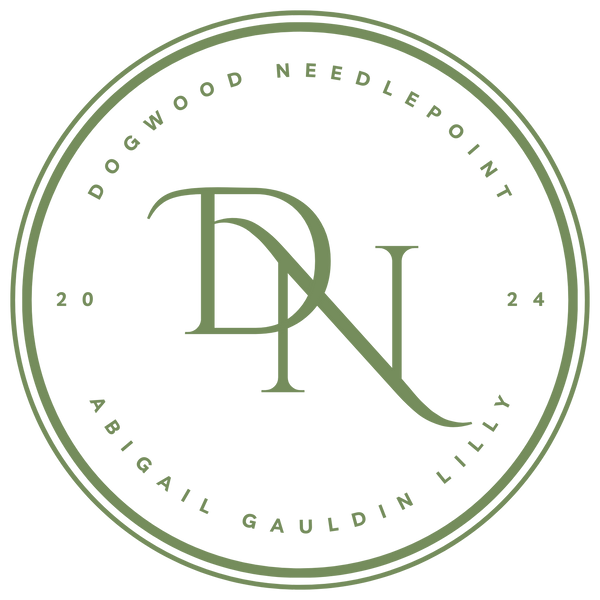Needlepoint 101
So what is Needlepoint? We first need to understand what needlepoint is. By definition, it is a form of counted thread embroidery, where you stitch designs onto canvas using threads. The stitches are typically in a diagonal stitch, covering the entire surface of the canvas.
Familiarize yourself with basic needlepoint terminology, like "canvas," "threads," "stitch," "skein," "ort," "LNS," "WIP," and "kitting." We could go on and on, but before you know it, you'll be speaking this funny language!
Let's Get into Basic Supplies
Needlepoint Canvas
Choose the right canvas mesh for your project. The smaller the mesh (higher count), the finer the stitches. Here at Dogwood Needlepoint, we have 13ct and 18ct, and we use Zweigart Mono Canvas.
Needles
Use tapestry blunt-end needles specifically designed for needlepoint, to prevent damaging the canvas. All orders come with the appropriate needle size, size 22 for 18ct and size 20 for 13ct canvas.
Fibers
Choose threads such as wool, cotton, silk, silk blends, metallic, velvet, etc. There are so many fibers to choose from to give your canvas character. DMC is the most budget-friendly brand of fiber if you are just getting started. Some personal favorites at Dogwood Needlepoint are Silk&Ivory and Very Velvet. A good rule of thumb when stitching with an assortment of fibers is to stitch light to dark. Be sure to leave bright, saturated colors, such as red, until the surrounded area has been stitched. This is done so your light fibers don't pull from your darker fibers.
Scissors
You will need a small pair of sharp scissors to cut threads as you go. My personal favorite is the Bohin Stork Scissor.
Stretcher Bars
While not necessary, a frame can hold your canvas taut while stitch, helping maintain even tension and preventing the canvas from warping. Holding your canvas in hand works just fine as well!
Prepare Your Canvas
Make sure your canvas has taped edges to ensure the canvas does not unravel as you work. Most needlepoint stores tape their canvas edges, and if you order a canvas from Dogwood Needlepoint, it will be taped too!
If you are using stretcher bars, secure the canvas to your frame using pins, and then you are ready to go.
Choose Your Stitches
The most common stitch for beginners is the Tent Stitch (or Half Cross Stitch). Once you’ve mastered this, you can experiment with others like Basketweave, Gobelin, and more.
Practice stitching on a small scrap of canvas to get the hang of your chosen stitch.
Thread Your Needle
Cut a length of thread (about 18 inches) to avoid tangling. You can also cut your fiber where it loops, and this will give you a workable length as well.
Make sure your is thread is not too long, to avoid fraying.
Follow Your Design
Use the painted pattern to guide you as you stitch. Think of it as paint by numbers but covering each intersection with a stitch.
Finishing a Piece of Thread
When you’ve completed a section, secure the end of your thread on the back of the canvas by weaving it through the existing thread on the back of the design to secure the end.
Trim excess thread and move to the next color or section.
Final Touches
Once your project is complete, carefully remove it from the frame, if used.
If desired, you can block your finished work to smooth out any distortions.
You can frame your needlepoint, make a pillow, create a Christmas ornament, or create anything your heart desires to showcase your beautiful work!
